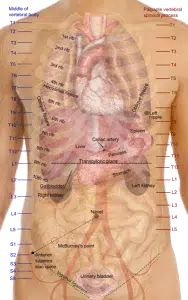What is Visceral Fascia?
The medical term for the body’s internal organs is ‘viscera.’
Like all soft tissues, the viscera is enveloped in fascial connective tissue called the visceral fascia. Visceral fascia envelops and protects all of our organs, anchoring them to each other and to the internal aspect of the rib cage, sternum, and pelvic girdle.
Examples of organ fascia include the pericardium of the heart, the pleura of the lungs, and the peritoneum of the intestines. Like all fascia, visceral fascia has pain receptors and nerve connections into the spinal cord. Because of this, it can become dysfunctional (restricted) causing a myriad of medical conditions ranging from chronic back pain to irritable bowel syndrome.
What are the Symptoms of Visceral Dysfunction?
 The potential for fascia to become scarred or restricted following a surgical procedure does exist and is well documented in the medical literature. What is also documented in the literature, but is much less widely known, is the fact that visceral fascia is contractile.
The potential for fascia to become scarred or restricted following a surgical procedure does exist and is well documented in the medical literature. What is also documented in the literature, but is much less widely known, is the fact that visceral fascia is contractile.
This is because fascia contains myofibroblasts. These smooth muscle cells are embedded in the fascia and are attached to an extensive “lattice like” network of collagen fibers that allows fascia to contract in a uniform manner.
Restricted visceral fascia is capable of causing the regional, surface muscle tissues to contract and can present clinically as chronic musculoskeletal conditions that don’t respond to surface treatments. Symptoms include: chronic neck / mid back pain, lower back pain, sacroiliac dysfunction, sciatica, shoulder pain, abdominal pain, chest wall pain, even pelvic floor dysfunction.
How Does Visceral FCS Work?

The release position is maintained for up to 40 seconds to allow local areas of trapped inflammation to dissipate, breaking the chronic pain cycle.
Click here for a detailed explanation of how FCS works.
Can visceral dysfunction directly impact the function of the organs themselves?
The answer is “yes” because the visceral fascia is supplied by the same autonomic nerves that lead to the organs themselves. Irritation of these nerves can cause chronic organ complaints such as urinary urgency, constipation, pancreatitis, even unknown abdominal pain. Visceral Counterstrain is only utilized for organ complaints that have first been thoroughly evaluated by a physician for organ disease.
How Can I Receive Visceral FCS?
Fascial Counterstrain for the viscera is currently utilized by physical therapists and other medical practitioners throughout the United States. The technique was developed over an eleven-year period from 1999 to 2010 by Brian Tuckey PT, OCS, JSCCI.
If you feel you may have symptoms related to visceral dysfunction, feel free to set up a detailed evaluation with one of the FCS trained practitioners at Tuckey and Associates Physical Therapy or use the Counterstrain.com or JIcounterstrain.com websites to find a trained practitioner in your area.

